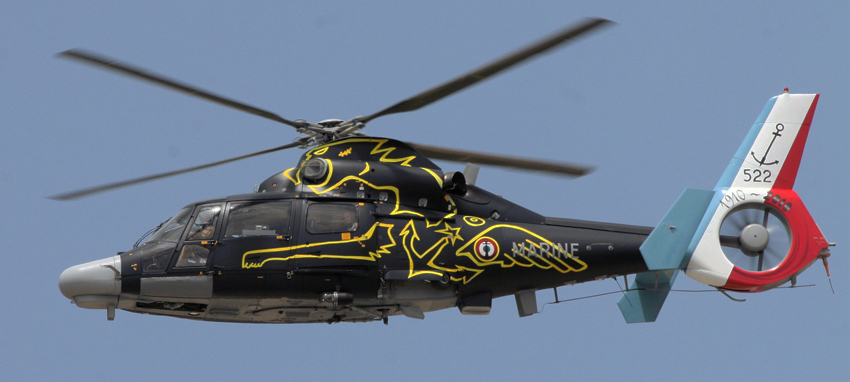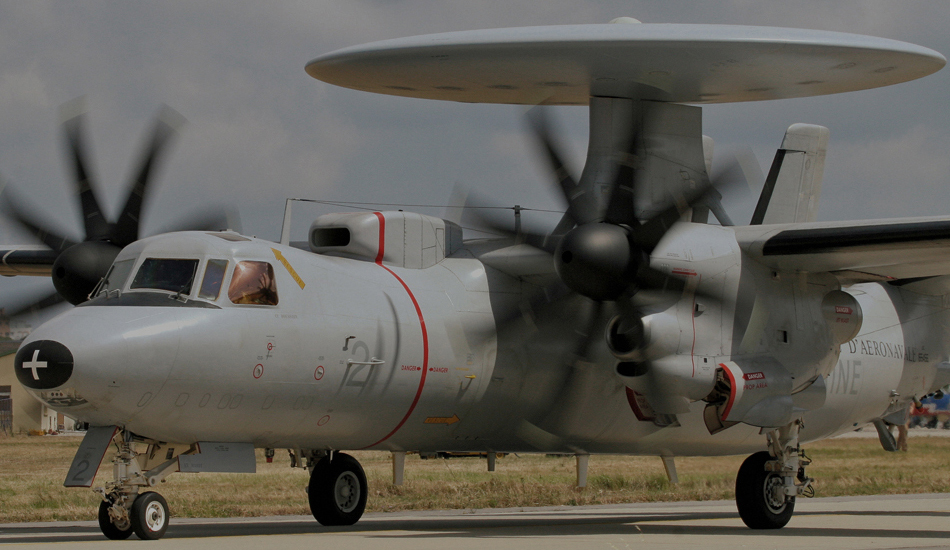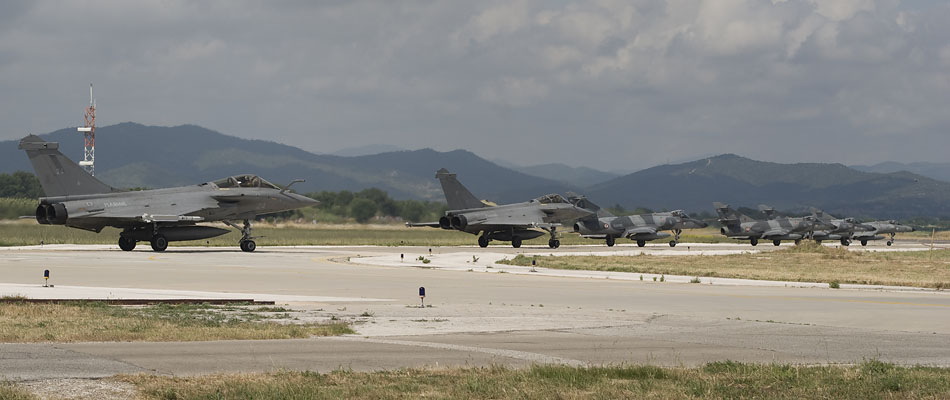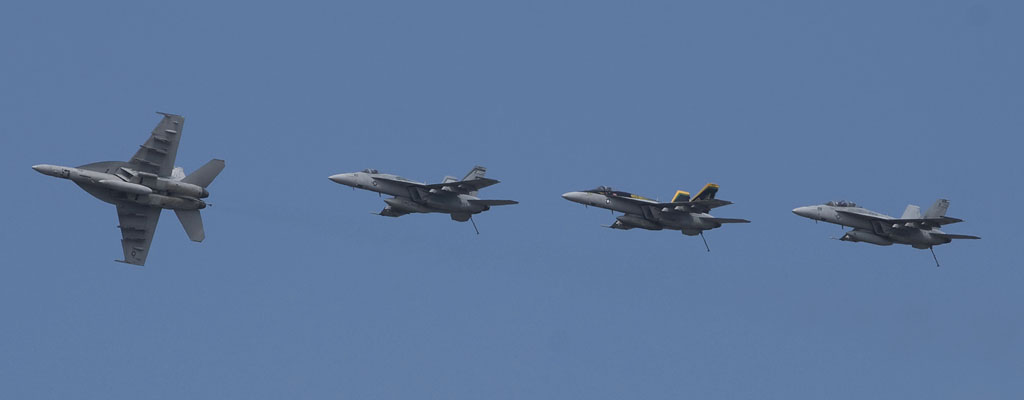 |
 |
 |
L’Aviazione navale abbozza i suoi primi passi nel novembre del 1910 quando un pilota statunitense, Eugéne Ely effettua il primo decollo da una nave da guerra la “USS Birmingham”; dall’inizio del 1910 il Ministero della Marina francese fermamente convinto del potenziale espresso dall’Aviazione invia sette giovani ufficiali ai corsi di pilotaggio, nel dicembre del 1910 la Marina francese acquista il suo primo velivolo un biplano Farman.
Muove così i suoi primi passi quella che diventerà l’Aéronautique Navale, la ricorrenza di un secolo di vita non poteva certamente non essere colta e celebrata con un evento “aeronautico” di tutto rispetto, il 13 giugno sulla BAN Hyéres nei pressi di Tolone; scelta dettata dai fatti storici, su questa base venne infatti istituita il 26 Febbraio 1924 il (CAM) Centre d’Aviation Marittime du Palyvestre, ma prima di entrare nel vivo della manifestazione ripercorriamo brevemente gli eventi salienti di questa storia centenaria.
La “Foudre”, anziano cacciatorpediniere fu la prima nave destinata a supportare, dopo alcune modifiche apportate nel 1911, i primi idrovolanti della marina francese, solo nel 1914 avvenne un decollo effettivo sempre da questa nave attrezzata con un ponte di volo, nel 1920 toccò invece al primo appontaggio. Allo scoppio della prima guerra mondiale in carico all’Aeronavale comparivano 25 aeromobili e poco più di un centinaio di addetti, la missione principale era quella ricognitiva, giunti al termine del conflitto erano allineati 1.260 idrovolanti e 200 aerostati con una forza di 630 piloti, 104 piloti di dirigibile ed 11.000 militari.
Solo nel 1927 viene messa in servizio una vera e propria portaerei, “Bearn” è il nome di battesimo, ma è il secondo conflitto mondiale che evidenzia la necessità per la Marina di incrementare la flotta, la Gran Bretagna cede un vecchio cargo trasformato in portaerei di scorta che viene battezzato “Dixmude” nell’Aprile del 1945, l’anno successivo sempre gli inglesi prestano per cinque anni la “Colossus” una portaerei leggera, nel 1951 questa viene ceduta alla marina francese che la ribattezza “Arromanches”, gli statunitensi cedono nel 1951 la “Langley” che viene ribattezzata “La Fayette” e nel 1953 sempre dagli USA viene trasferita la “USS Belleau Wood” ribattezzata “Bois Belleau”. |
|
|
 |
|
|
|
|
 |
|
|
|
|
 |
I primi velivoli utilizzati furono i Dewoitine D1.C1 (1927-1932), Breguet 521 Bizerte (1935-1942), Latécoère 298 (1938), Glenn Martin 167 (1940), Hudson (1940), Wellington (1943-1952), PBY5A Catalina (1944-1951), Seafire (1946-1950), Dauntless (1944-1949), Helldiver (1949-1951), Bloch 175 (1947-1952), Hellcat (1950), Avenger (1951-1960), PB4Y Privateer (1951-1961), Lancaster (1952-1958), Corsair I (1952-1964), Neptune (1958-1983) nel 1955 (1955-1966) venne messo in servizio il primo velivolo a getto l’Aquilon (1955-1966 DH Venom NF-2) che però sino all’avvento della “Clemenceau” non potè essere imbarcato.
Nel 1954 arriva nelle file dell’Aviazione Navale l’elicottero, vengono acquisti i Piasecki HUP-2 per garantire i servizi di salvataggio durante le operazioni marittime, mentre per le missioni di trasporto e d’assalto veniva utilizzato il Vertol-Piasecki H21C Banane (1956-1960).
I principali eventi che caratterizzarono le operazioni dell’Aeronavale furono la guerra d’Indocina dal 1945 al 1956, la crisi di Suez nel 1956 e l’intervento in Algeria dal 1956 al 1962. Ulteriori importanti date da considerare furono: il primo appontaggio di un velivolo a getto, che avvenne sulla Clemenceau il 5 Aprile 1960, ancora in fase di sperimentazione prima della effettiva messa in servizio il 22 Novembre del 1961, l’occasione aprì le porte all’utilizzo dei velivoli più moderni come l’Etendard IVM (1961-1980), CM 175 (1959-1995) ed il Vought F-8E (FN) Crusader (1965-1999); nel 1956 a pari passo con i velivoli a getto venne introdotto in servizio il primo elicottero a turbina l’Alouette II e per rimanere sul tema dell’ala rotante un breve accenno agli altri tipi di elicottero che militarono nella forza armata S 55 (1958-1960), S 58 (1960-1979).
Il meeting è stato organizzato con una discreta componente storica proprio a voler rimarcare le radici centenarie nonché l’accomunamento con le forze armate di marina dei paesi amici, Spagna, Italia, Stati Uniti, Gran Bretagna, Germania.
Presenti nella rada di Tolone le portaerei USS Truman (USA), Charles de Gaulle (Francia), Principe de Asturias (Spagna), Argus (Regno Unito), le fregate Essen (Germania), Forbin (Francia), Normandy (USA), il lanciamissili Norman (USA) ed il trasporto d’assalto Foudre (Francia). |
 |
|
|
 |
|
|
|
|
 |
|
|
La manifestazione è stata aperta con il decollo ed alcuni passaggi della ricostruzione di un Bleriot XI-2 dell’Amicale Jean Baptiste Salis, seguito da tutta la serie dei vintage, alcuni nei colori dell’Aeronavale come il Corsair e l’Avenger, altri nei colori originali come lo Spitfire o lo Ju 52, ben 33 velivoli civili erano presenti sul piazzale, le esibizioni degli “old timer” venivano intervallate dalla Patrouille de France e da un Rafale in rappresentanza dell’Armée de l’Air, mentre l’Armée de Terre ha effettuato una dimostrazione con un elicottero Tigre del centro di addestramento di Le Luc.
Massiccia presenza della marina statunitense con la rappresentanza di un gruppo imbarcato sulla “USS Truman” con C 2A Greyhound, SH 60B Seahawk, E 2C Hawkeye, F/A 18E/F Super Hornet, gli aviatori di marina americani hanno contribuito alla dimostrazione in volo con la partenza della pattuglia di Super Hornet che effettuava alcuni passaggi in formazione stretta. Non poteva mancare l’AV 8B della marina spagnola che ha messo in evidenza le caratteristiche del velivolo a decollo verticale; inglesi, tedeschi ed italiani si sono limitati alla presenza in mostra statica con Harrier, EH 101, Jetstream, Atlantic; altri vintage presenti erano un Noratlas, due C 47 Dakota, mentre l’esemplare del FW 190, durante le prove di volo di sabato 12 giugno, ha sofferto una piantata motore e con notevole capacità del pilota Marc Mathis è stato condotto all’ammaraggio sul basso fondale prospiciente la base aerea, immediato l’intervento di alcune persone con degli scooter marini che l’hanno estratto dall’abitacolo in ottime condizioni, contemporaneamente è avvenuto il decollo su scramble del Dauphin, in stand-by, sulla base per l’intervento di soccorso.
La mostra statica era completata con un esemplare di ogni velivolo in dotazione alla Aeronautique Navale, alcuni con la speciale livrea del centenario, il clou della dimostrazione in volo è stata dei padroni di casa con formazioni miste di Super Etendard Modernisè, Rafale M, E 2C, rifornimento in volo tra due SEM, simulazione di operazioni di salvataggio e Combat SAR con elicotteri Phanter, Lynx e Alouette III.
Una particolare menzione và all’organizzazione, per quella parte dedicata agli Spotter, gestita in maniera veramente impeccabile, sia per la disponibilità del personale che per la sistemazione logistica, nonché per la gradita “sorpresa” dell’estensione anche alla domenica dell’ingresso all’area predisposta per i fotogiornalisti |
 |
|
|
 |
|
|
|
|
 |
|
|
|
|
 |
|
|
|
|
 |
|
Foto e testo di Aldo Ciarini
Giugno 2010
|
|
English translation by Frank McMeiken
Naval aviation took its first primitive steps in November 1910 when an American pilot, Eugéne Ely, performed the first take-off from the U.S. Navy warship “USS Birmingham”; at the beginning of 1910 the French Naval ministry, firmly convinced of the potential offered by aviation, sent seven of its young officers on a flying training course, while in
December 1910 the Marine Nationale acquired its first aircraft, a Farman biplane.
These early developments laid the ground for what would become the Aeronautique Navale. The milestone of a century of existence could certainly not be celebrated without a dedicated "aviation" event, held on 13 June at BAN Hyères near Toulon; the location was dictated by historical precedence, as at the base, on 26 February 1924, the (CAM)
Centre d’Aviation Marittime du Palyvestre was created. Before entering into detail about the celebratory event, it is worth examining the salient events of the force's past one hundred years.
The “Foudre”, an ancient destroyer, was, following some modifications completed in 1911, the first ship utilised to support seaplane operations by the French Navy. It was 1914 when an aircraft made the first take-off from a flight deck installed on the same ship, while the
first landing occurred in 1920. On the outbreak of the First World War the Aeronavale's fleet comprised 25 airships and just over one hundred staff: its principal mission was reconnaissance. By the end of the conflict the force had increased to 1,260 seaplanes and 200 airships, with a staff of 630 aircraft pilots, 104 airship pilots, and 11,000
support personnel.
Only in 1927 was a proper aircraft carrier introduced, the “Bearn”, but it was the Second World War that would demonstrate the French Navy's need to increase its fleet. Great Britain ceded an old cargo ship that had been converted into an escort carrier, baptised “Dixmude” in April 1945. In the following year the British also loaned the “Colossus” light
carrier for five years. In 1951 this was transferred to the French, who named the ship “Arromanches”. The Americans transferred the “Langley” in 1951, which was re-baptised “La Fayette”, and in 1953 the USA passedon the “USS Belleau Wood” re-baptised “Bois Belleau”.
The first aircraft utilised were the Dewoitine D1.C1 (1927-1932), Breguet 521 Bizerte (1935-1942), Latécoère 298 (1938), Glenn Martin 167 (1940), Hudson (1940), Wellington (1943-1952), PBY5A Catalina (1944-1951), Seafire (1946-1950), Dauntless (1944-1949), Helldiver (1949-1951), Bloch 175 (1947-1952), Hellcat (1950), Avenger (1951-1960), PB4Y Privateer (1951-1961), Lancaster (1952-1958), Corsair I (1952-1964), and Neptune (1958-1983). In 1955 (1955-1966) the first jet aircraft, the Aquilon (1955-1966 DH Venom NF-2) entered service, but could not be embarked until the arrival of the “Clemenceau”.
1954 saw the Aeronautique Navale accept its first helicopters, the Piasecki HUP-2, intended to undertake rescue operations during maritime operations, and the Vertol-Piasecki H21C Banane (1956-1960), utilised for transport and assault missions.
The principal events which have characterised the operations of the Aeronavale have been the war in Indochina between 1945 and 1956, the Suez crisis in 1956, and the intervention in Algeria between 1956 and 1962. A further important event to mention was the first deck landing by a jet aircraft, conducted on the Clemenceau on 5 April 1960, still
undergoing sea trials prior to entering service on 22 November 1961: this opened the doors to the use of more modern aircraft, like the Etendard IVM (1961-1980), CM 175 (1959-1995) and Vought F-8E (FN) Crusader (1965-1999); in 1956, coincidental with the first jet aircraft, the first turbine powered Alouette II helicopter entered service: other
rotary winged types which would serve with the French Navy included the S 55 (1958-1960), and S 58 (1960-1979). The meeting was organised to include both a significant historical component, intended to remind visitors of the hundred years of history
and an indication of the links developed with the naval forces of other friendly nations: Spain, Italy, United States, Great Britain, and Germany.
Anchored in the bay off Toulon were the carriers USS Truman (USA), Charles de Gaulle (France), Principe de Asturias (Spain), Argus (United Kingdom), the frigates Essen (Germany), Forbin (France), Normandy (USA), the missile launcher Norman (USA), and the assault ship Foudre (France).
The display was opened with the take-off and a few flypasts of a replica
Bleriot XI-2 from the Amicale Jean Baptiste Salis collection, followed by a series of vintage aircraft, some in the colours of the Aeronavale, like the Corsair and Avenger, and others in their original paintwork, like the Spitfire or Ju 52. Some 33 civilian aircraft were also on the
ramp. The exhibitions of the “old timer” were mixed with those of the Patrouille de France and a Rafale, representing the Armée de l’Air, while the Armée de Terre flew a demonstration with a Tigre helicopter from the Le Luc training centre.
The United States Navy was present in strength, represented by a selection of aircraft deployed from the “USS Truman” Carrier Air Group, a C 2A Greyhound, SH 60B Seahawk, E 2C Hawkeye, and F 18E/F Super Hornet. The American naval aviators also participated in the flying display, with the departure of a pair of Super Hornet, which then
performed a few flypasts in tight formation. An AV 8B of the Spanish Navy provided an excellent demonstration of the characteristics of the aircraft in vertical flight. The British, Germans and Italians limited their presence to the static display, bringing Harrier, EH 101, Jetstream, and Atlantic; other vintage aircraft on show were a Noratlas and two C 47 Dakota, while the example of the FW 190, during the practices on Saturday 12 June, suffered an engine failure, making, thanks to the skills of its pilot Marc Mathis, safely ditched on the mud flats that surround the base, being immediately assisted from the
cockpit by rescue personnel arriving on jet skis. The accident also resulted in the scramble of the based Dauphin, held at readiness on the base for rescue operations.
The static display was completed by an example of every aircraft in service with the Aeronautique Navale, some of which wearing special commemorative liveries. The highlight of the flying display was provided by the based units, who flew a mixed formation comprising Super Etendard Modernisè, Rafale M, and E-2C, demonstrated in-flight refuelling between two SEM, and simulated rescue and Combat SAR with Phanter, Lynx and Alouette III helicopters. The organisers deserve a special mention for the facilities made available to the enthusiasts, organised in a truly impeccable manner in terms of both the assistance provided by the personnel and the logistical organisation, as well as the unexpected surprise of the extension into the Sunday of the area set aside for photo journalists.
|
|
Images and text by Aldo Ciarini
June 2010
|
|